Month: June 2009
Saved By The Rails
In today’s N.Y. Times A.O. Scott makes a good point about The Taking of Pelham 1 2 3, which is that the “stubborn, earthbound fact of the subways serves as an anchor” for director Tony Scott. “The gritty physicality of subway cars and tunnels balances the director’s signature flights into G.P.S. and Google Earth-inspired bird’s-eye moviemaking, constraining his indulgences much as it limits the options of both the criminals and the civic authorities in the movie.
Another good quote: Costars Denzel Washington and John Travolta “interact mostly via squawk box, cellphone and radio. But even at a distance from each other, they conduct a tag-team master class in old-style movie star technique, barreling through every clich√© and nugget of corn the script has to offer with verve and conviction. Even when you don’t really believe them, they’re always a lot of fun to watch.”
The Taking of Pelham 1 2 3 “is neither too raw nor too nostalgic,” adds Entertainment Weekly‘s Lisa Schwarzbaum. “And in the hands of director Tony Scott, it’s relevant but not too distressing, something that doesn’t shy away from jolting violence but is also, you know, fun. It’s an open-hydrant whoooosh of an action thriller.”
$65 Million Dollar Man
Two days ago Forbes‘ Dorothy Pomerantz reported that Harrison Ford earned $65 million dollars between June ’08 and this month, mostly or entirely through his Indiana Jones and the Kingdom of the Crystal Skull profit percentage deal. That awful film has grossed $786 million worldwide.
Sixty five friggin’ million for donning the old fedora, holding his nose and starring in a megapic that (a) made him look like much more like a corporate go-alonger than a studly movie star, (b) all but ruined the viability of the Indiana Jones franchise and (c) cemented George Lucas‘s reputation as a legendary spoiler and degrader of potentially wow films.
The second biggest 6.08 to 6.09 earner was Adam Sandler, who made $55 million off fees and whatnot stemming from You Don’t Mess With the Zohan and Bedtime Stories. Will Smith came in third with a lousy $50 million for his work on Hancock and Seven Organs for Seven People…Jesus God.
The universally loathed and despised Eddie Murphy came in fourth via his earnings the mediocre Meet Dave. In fifth place was the dedicated workhorse Nicolas Cage.
Earnings estimates were based on talks with “agents, managers, producers and lawyers to determine what the stars earned as upfront pay on movies [stars] are currently shooting, as well as backend pay earned after a movie hit the theaters.” Forbes also tabulated “any money actors might have earned from doing ads for things like beer, banks and coffee.”
Tom Hanks came in sixth with $35 million followed by Tom Cruise ($30 million, 7th place), Jim Carrey ($28 million, 8th place), Brad Pitt (a lousy $28 million? With all those kids and all that travel?), and Johnny Depp ($27 million, 10th place).
The elite bottom-feeders are George Clooney ($25 million), Russell Crowe ($20 million…lifestyle cutbacks!), Robert Downey Jr. ($20 million, 13th place), Denzel Washington ($20 million), Vince Vaughn ($14 million), Ben Stiller ($14 million, second mortgage), Seth Rogen ($12 million, enough for starter home and nice second-hand Taurus), Matt Damon ($11 million…what’s he doing?), Christian Bale ($10 million, 19th place), and Will Ferrell ($10 million).
Ich Bin Ein Slow Guy
There’s a small but stunning “whoa!” in Brooks Barnes‘ 6.14 N.Y. Times piece about how Bruno simultaneously mocks and elbow-nudges homophobia. Universal, the film’s distributor, “won’t discuss the filmmaking process,” he writes, “but the studio insists that the vast majority of the people who appear with Sacha Baron Cohen had no idea they were being filmed for a Hollywood movie.”

This is the article‘s big whopping obiter dicta — the words in passing that suggest there’s no limit to average people’s ability to keep their brains from noticing or absorbing anything that doesn’t naturally reside in their own private intellectual and emotional gulags. To delicately rephrase, after Borat you really needed to be a complete cultural hillbilly not to be aware that Cohen would be out and about last year filming Bruno in a blonde wig.
I’m mentioning this because it suggests, obviously, that the core element in Bruno, like in Borat, is a relentless expression of disdain for Middle American zombie culture.
“In mercilessly exploiting the discomfort created when straight men are ambushed by aggressive gayness, Bruno happens to (surprise!) expose homophobia,” writes Barnes. “Gay groups are reacting with deeply mixed emotions, heightened by the recent triumphs (Iowa) and losses (California) in efforts to legalize gay marriage. Is the film then vulgar, inappropriate and harmful? Or bold, timely and necessary? All of the above?
“Ultimately the tension surrounding Bruno boils down to the worry that certain viewers won’t understand that the joke is on them and will leave the multiplex with their homophobia validated.
“‘Some people in our community may like this movie, but many are not going to be okay with it,’ said Rashad Robinson, senior director of media programs for the Gay and Lesbian Alliance Against Defamation. ‘Sacha Baron Cohen’s well-meaning attempt at satire is problematic in many places and outright offensive in others.’
“Holding the opposite view are people like Aaron Hickland, the editor of Out magazine, who said he plans to put Mr. Baron Cohen on the August cover. ‘The movie does something hugely important, which is showing that people’s attitudes can turn on a dime when they realize you’re gay,’ Mr. Hickland said. ‘The multiplex crowd wouldn’t normally sit down for a two-hour lecture on homophobia, but that’s exactly what’s going to happen. I’m excited about that.’
“Bruno is not a lecture, at least not overtly. Like Borat: Cultural Learnings of America for Make Benefit Glorious Nation of Kazakhstan, the 2006 smash that starred Mr. Baron Cohen as an anti-Semitic Kazakh journalist, Bruno is first and foremost a raunchy comedy featuring a not-so-bright guy who embraces sexism, racism and stereotypes as he happily goes about his business. Borat and Bruno are both familiar to fans of Da Ali G Show, Mr. Baron Cohen’s satirical talk show, which first ran in Britain in 2000 and began appearing on HBO in 2003.
“Yet Bruno is also intended as a statement about what it is like to be a member of a minority in America in 2009. Mr. Baron Cohen’s malaprop-loaded antics are fictional, but the hate they can elicit from the people he encounters is ostensibly real. (The same was true of Borat, which some human rights groups also greeted with hostility; Abraham H. Foxman of the Anti-Defamation League said at the time that audiences ‘may not always be sophisticated enough to get the joke’).”
“The Big Hate”
“Some figures in the conservative media have refused to go along with the big hate — people like Fox’s Shepard Smith and Catherine Herridge, who debunked the attacks on that Homeland Security report two months ago. But this doesn’t change the broad picture, which is that supposedly respectable news organizations and political figures are giving aid and comfort to dangerous extremism.
“What will the consequences be? Nobody knows, of course, although the analysts at Homeland Security fretted that things may turn out even worse than in the 1990s — that thanks, in part, to the election of an African-American president, “the threat posed by lone wolves and small terrorist cells is more pronounced than in past years.
“And that’s a threat to take seriously. Yes, the worst terrorist attack in our history was perpetrated by a foreign conspiracy. But the second worst, the Oklahoma City bombing, was perpetrated by an all-American lunatic. Politicians and media organizations wind up such people at their, and our, peril.” — from Paul Krugman‘s 6.12 N.Y. Times column (which went online last night).
Evil Is Banal
Conservative columnist and opportunist S.E. Cupp, a contributor to Politico and the Washington Post, tells Sean Hannity that President Obama is to blame for David Letterman‘s Sarah Palin routine the night before last. “I’m not saying this to be inflammatory,” she said, “[but] I blame Barack Obama…he allowed his surrogates to talk this way.”
“Allowed”? Marching in absolute uniform lockstep is a right-wing thing. Liberals wake up in the morning and decide what they’re going to say and do on their own. They don’t take orders or sing to the media from pre-prepared hymns.
Visit msnbc.com for Breaking News, World News, and News about the Economy
Woody, Larry, Rachel, Patricia
The Whatever Works team — director-writer Woody Allen, costars Larry David, Evan Rachel Wood and Patricia Clarkson — held a press conference early this afternoon at the Hotel Regency. Here’s an mp3 of the whole thing. A good thing, several laughs, time well spent.
Allen, typically candid and clever and self-deprecating, got the biggest laughs. David amused here and there but was mainly plain-spoken. Clarkson got off a few good ones. Wood looked very uptown and older than her 22 years with reddish swept-back hair — Suzie Parker circa 1958.
I asked a slightly off-center question about how much of the humor and dialogue felt misanthropic when I first saw Whatever Works a few weeks ago, particularly in the way Allen views folks from the hinterlands, but that two recent political murders by right-wing loonies had made the film seems less misanthropic on a certain level. Woody got a good laugh when he answered that he’s “against murders,” but then he went with the thought and riffed a bit about what a horrific and threatening place the world seems to be on a daily basis.
“Think of that one scene in Hannah and Her Sisters when Max Von Sydow, playing a cynical painter, rails against money-mad Christian preachers, and then multiply it 100 times and then make it a bit meaner,” I said in my 4.22 review, trying to sum up the film.
“But what the characters say and finally do in Whatever Works isn’t cause for anyone’s misanthropy. The story is about people changing and adapting and going with the flow, and it ends on a gracious and generous note.”
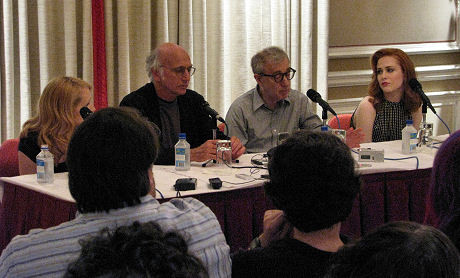
(I. to r.) Patricia Clarkson, Larry David, Woody Allen, Evan Rachel Wood — Thursday, 6.11, 2:10 pm.
Debacle of G.I. Joe
I’ve been told that story about Stephen Sommers‘ removal from G.I. Joe: The Rise of Cobra (Paramount 8.7) isn’t far from the truth and at least deserves a read. It comes from a guy named “End Times.” He posted the account last night on Don Murphy’s site. [Note: story was removed yesterday morning.]
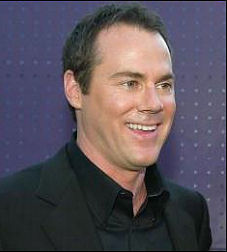
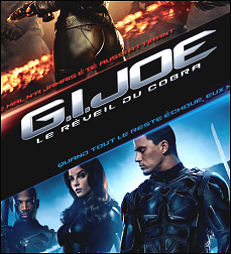
G.I. Joe director Stephen Sommers; French poster art
My source says Sommers “was given total freedom but he melted down and has made the biggest bomb in many a moon. Paramount production chief Brad Weston is looking to bail and work for Peter Chernin with Star Trek as his coda because G.I. Joe will decimate the Paramount team and lead to many, many scapegoats.”
Here‘s the “End Times” account with comments:
“After a test screening [of G.I. Joe: The Rise of Cobra] in which the film got the lowest test score ever from an audience in the history of Paramount, the executive who pushed for the movie — Brad Weston — had Stephen Sommers, the superhack director of the film, fired. Removed. Locked out of the editing room.” Wells comment: How does this guy know what Paramount’s test-scoring history is? Does he have all the stats? If so, how did he get them?
“Stuart Baird, a renowned fixer editor, was brought it to try to see if G.I. Joe could be made releasable. Meanwhile producer Lorenzo di Bonaventura, whose turkey Imagine That (also championed by Weston) explodes this weekend as the new bomb in theatres, was told his services were no longer needed on the film either.” Wells comment: Someone needs to call around and verify and round this out.
“Sommers was then forced by his William Morris agents to pretend that he was working on Tarzan over at Warner Brothers, doing design work, even though that film doesn’t even have a good script yet. When word of the firing started to be whispered about in Hollywood, Sommers was summoned back to the editing room but merely to save appearances. Baird is still re-editing the movie with studio input.
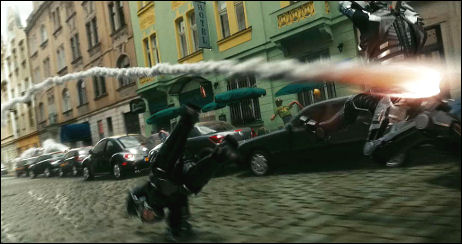
“Hasbro CEO Brian Goldner, who turned down other offers from the property to go with the script that was rushed out in eight weeks by Stuart Beattie (i.e., because of the writer’s strike), is frantic that the Sommers-created debacle will destroy the brand and is now distancing himself from the pending catastophe.
“None of this needed to happen. The problem is that someone did not know the mythology. Lorenzo di Bonaventura was in charge of the film and never contradicted Sommers on anything. Lorenzo, so you know, was previously a senior Warners honcho and had GI Joe under option there (not as a producer) for seven years and he refused to greenlight the film, stating that because he grew up in Italy he had no knowledge of it.
“If you google enough, at one point you will see he wanted the film to be about an action hero named Mann (Action Man…got it) and he clearly had no clue what the GI Joe world really was.
“And the hapless hack Sommers? Where did he come from? The confused Jon Fogelman at William Morris, who signed Hasbro away from CAA, had to find a director in a hurry for his new clients and gave [Paramount] the only guy who he repped who would do it. A sad end to what could have been a great franchise. Acceleration suits indeed.”
Update: Movieline‘s Kyle Buchanan posted a followup a few hours ago, the gist saying that “sources” have told him that Sommers is still on the film.
So I got in touch with my guy and here’s what he said: “The bottom line is that you don’t read stuff like this about a film that’s working. The bad buzz around G.I. Joe has been swirling around for a long time. The studio knows it’s a bomb and is trying to mitigate the disaster.
“Sommers’ complete autonomy got them into this mess, but he doesn’t have it anymore. He was petulant and demanding throughout the production and got his way at every turn, until now. This isn’t about his final cut nor anyone’s respective ‘vision’ as they’re now mightily endeavoring to get a version of this film together that’s releasable and can get the biggest opening possible.
“One person at Paramount said it’s the weakest major release since Escape From L.A. Any hopes for a new tentpole are completely gone.”
Not Quite As Harsh
Update: Okay, Andrew Sarris will continue reviewing for the New York Observer as a freelancer, according to Dave Kehr. Great! I don’t know why Sarris didn’t point this out when we spoke last night but whatever. At least the berth continues.
Posted this morning: Hearing yesterday that Andrew Sarris had been jettisoned by the N.Y. Observer resulted in one of those pit-of-the-stomach thud feelings. Sarris, 81, is getting on (who isn’t?) and maybe slowing down a tad but he’s way too important, too influential and too legendary to just be cut from the payroll. We all know about the cultural shiftings going on (“The age of the singular critical voice is ending — people prefer the wisdom of a community”) but this still ain’t right.
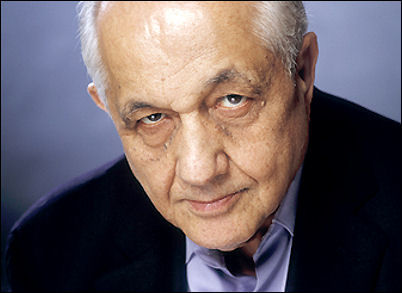
Andrew Sarris
In other words the man has been at this racket for way too long and writing too insightfully and has been too much of a steady trooper for too many decades for some editor to just say “okay, see ya.” (Sarris’s first film review focused on Alfred Hitchcock‘s Psycho.) In my head he’s earned the stripes to just keep on rolling until he wants to stop. He personifies hallowed ground.
So I called Sarris last night and said it was personally upsetting to hear what happened, etc. I asked if he’d given any thought to writing for a reputable website. He seemed open to the idea (we talked about a possible option or two) but said he was also enjoying the downtime for the first time in 19 years. And he said thanks very much for the condolences and words of support.
Except too much downtime is bad for the spirit. Writing is brutal or difficult or at least a slog for most of us, but not writing is a death sentence. Writing keeps you in the game, sharpens your mind, makes you inquisitive, feeds the engine, keeps you on your toes, etc. All writers need to keep on chooglin’ until they drop. There is no spoon and there is no retirement.
Here’s Stephen J. Whitty‘s piece about Sarris’s current situation and reputation. And one from Some Came Running‘s Glenn Kenny. And an ’05 Film Comment piece from Kent Jones.
In the fall of ’77 Sarris agreed to talk about movies in front of a crowd at the Westport Country Playhouse Cinema, where I was working at the time. I was told to pick him up at his Upper East Side apartment and drive him up to Westport, and then drive him back a couple of hours later. We obviously enjoyed some chat time, but what I primarily remember was his energy and spirit — a genuine inspiration for me. He seemed indefatigable.
A year or two later I was a struggling New York freelancer, doubtful of my talent and unsure of my footing. I was at a black-tie New York Film Festival party, and I remember suddenly putting on a pair of jet-black Ray-Bans as I joined a group of five or six that included Sarris. He made me feel very much part-of-the-gang when he remarked a few seconds later that I looked “like a Roman pimp in a Fellini film.”
One of my all-time favorite Sarris lines is that “the bottom has fallen out of badness in movies.” He wrote this in the early ’80s….hah!
From the Film Snob’s Dictionary: “Sarris, Andrew. Brooklyn-born film critic and theorist known for popularizing the Auteur Theory, and for arousing the ire of Pauline Kael with his totemic 1968 book The American Cinema: Directors and Directions, 1929 — 1968, in which he categorized directors by preference, prompting Kael to deride him, to his face, as a ‘list queen.’
“His gentlemanly, hypeless prose has remained consistent since 1960, when he began writing for the Village Voice. Married to the fellow film-critster Molly Haskell, Sarris now plies his trade for the New York Observer and as a trainee Snob-admired lecturer at Columbia University.”
Arguing With Vegetables
I believe this Daily Kos “Termite” post because…I don’t know. Instinct? Mainly, I suppose, because Termite can write and has a two year-old daughter. Was Voight arguing with someone via an unnoticed Bluetooth earpiece during the bell peppers-and-celery dispute? That was one possibility that flew through my head when I first read it. But then Termite claims to have noticed grumpy-eccentric mutterings from the guy three times.
The link is inexcusably old — 18 hours or so — but by the time I saw it early yesterday evening I was in the city sans laptop. The new copy-and-paste software on iPhones is going to make filing on the go a lot easier.
